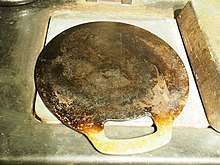Bakestone
A bakestone is a type of griddle, particularly associated with Wales where they are used for cooking Welsh cakes.[1][2]

Until the 19th century, bakestones were made of stone. They were usually oval and of slate or very fine micaceous flaggy sandstone about 1 1⁄2 inches (4 cm) thick.[3] Modern bakestones are usually circular with a cut-out handle and are made of cast iron or steel, approximately 1 cm (0.4 in) thick.
New bakestones are 'seasoned' by burning a mixture of lard or oil and salt, giving a non-stick surface and protecting against rust. The blackened surface is not removed when the bakestone is cleaned and bakestones are believed to improve with repeated use.[4]
In Lancashire and the West Riding of Yorkshire the name was spelt and pronounced bakstone and they were primarily used to cook very thin yeasted oatcakes or earlier riddlebread.[3]
See also
References
- Barraud, Winifred K. (9 November 1962). "Bakestone tradition". The Guardian. London. p. 8.
- "Welsh Bakestone Or Planc". Antique Kitchenalia. Archived from the original on 10 August 2015. Retrieved 9 November 2013.
- Hartley, Marie; Ingilby, Joan (1968). Life and Tradition in the Yorkshire Dales. London: J. M. Dent & Sons Ltd. ISBN 0498076687.
- "Seasoning A Bakestone". Antique Kitchenalia. Archived from the original on 11 August 2015.